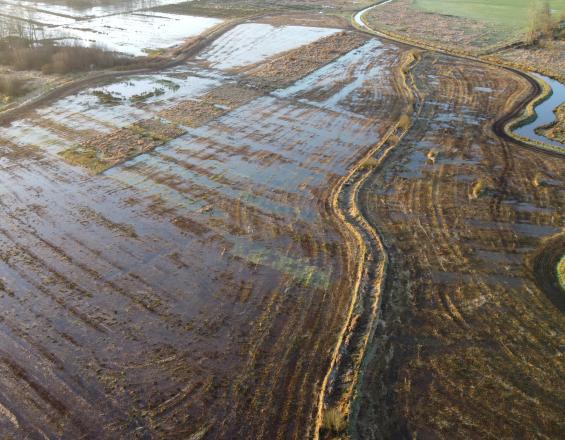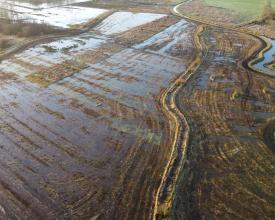
Hydrological restoration in drained fen peatlands

Peatlands are often drained by ditches and creeks in function of agriculture, resulting in ecosystem degradation, huge CO2-emissions and biodiversity loss. To restore these rare and important ecosystems, restoration is needed, provided that the water quality is sufficient. Restoration can be simple and cheap: Local ditches within the terrains need to be closed and larger creeks, that still need to transport some water, should be relevelled until ~20cm under ground level. To make sure the area won’t be flooded, a study or simulation of the effect using sandbags is needed to estimate relevelling impacts. Barrages in the creeks are not favoured due to their desiccating effect up to 30m away.
Local substrate should be used to close these ditches, so a homogenous peat layer is maintained. Often the creek banks are little elevated. If this is the case, these are used to fill up the creeks. If not, a small 10cm deep layer can be scraped off from the adjacent terrains. For this, small diggers can be used with a smooth bucket.
Impacts
Rewetting will result in a huge reduction of CO2-emission from the peatlands (roughly estimated on 1200 tons of CO2/Year/100ha), although it will take some time to settle. When water tables are higher, the peat layer can regain its water buffering function, both benefitting climate and biodiversity. Especially, the unpredictable climate events resulting from climate change can be buffered by an intact peat layer. Severe droughts can be buffered by the availability of water in the peat soils. Moreover, huge rainfalls can be buffered since the water will be taken up by the spongy peat soils. This avoids huge flooding downstream when rivers burst their banks. The water taken up in the peat soils will be released gradually. This specific solution aims towards an ecosystem restoration. Ideally, if the complete area can be restored, no human interference/water management will be needed in the future. The system can thus regulate itself again and regain its ecosystem services in the process. Ideally, in some years if the water table is stable enough, active peat formation can get going. Then, CO2 would not only be preserved in the peat soil and prevented from entering the atmosphere, but can be actively taken out of the atmosphere into the peat layer 10 times more efficiently than carbon sequestration in forests.










